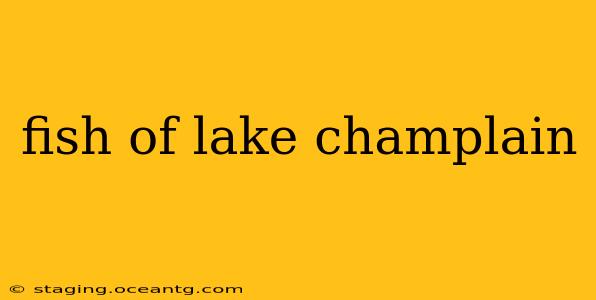Lake Champlain, a stunning body of water straddling Vermont, New York, and Quebec, is renowned not only for its picturesque scenery but also for its surprisingly diverse fish population. This article delves into the fascinating world of Lake Champlain's fish, exploring the various species that call this unique ecosystem home, the challenges they face, and the efforts to conserve this valuable resource.
What kind of fish are in Lake Champlain?
Lake Champlain boasts a remarkable variety of fish species, a testament to its complex and diverse ecosystem. You'll find both coldwater and warmwater species thriving here, reflecting the lake's varying depths and temperatures. Some of the most common include:
- Lake Trout: A prized coldwater species, Lake Champlain's lake trout population is actively managed to ensure sustainability. They are a significant part of the lake's recreational fishing industry.
- Landlocked Salmon: Another coldwater species, these salmon are a popular target for anglers, contributing to the region's economy.
- Northern Pike: A voracious predator, the northern pike is a key component of the lake's food web. Their presence helps maintain balance within the ecosystem.
- Walleye: A highly sought-after game fish, walleye are known for their delicious flesh and are a significant draw for sport fishing enthusiasts.
- Yellow Perch: A smaller, more abundant species, yellow perch are a crucial part of the food chain and a popular target for recreational fishing.
- Smallmouth Bass: Relatively common, smallmouth bass contribute to the overall biodiversity of the lake.
- Largemouth Bass: While not as abundant as smallmouth, largemouth bass are still found in certain areas of the lake.
- Chain Pickerel: A smaller, more elusive predator, chain pickerel play a vital role in controlling smaller fish populations.
What is the biggest fish in Lake Champlain?
While precise records can be challenging to verify, lake trout are frequently cited as among the largest fish found in Lake Champlain. Individual specimens weighing over 30 pounds have been reported, although these are less common. The size of fish, however, can vary significantly based on factors such as age, food availability, and water conditions.
Are there any endangered fish in Lake Champlain?
While many fish species thrive in Lake Champlain, several face challenges. Conservation efforts are crucial to maintain the health of the lake's ecosystem. Specific fish species facing challenges vary over time depending on environmental factors and management interventions. It's always advisable to consult up-to-date resources from state and provincial agencies responsible for fisheries management in the Lake Champlain basin for the most current information on endangered or threatened species.
What is the most common fish in Lake Champlain?
The most common fish in Lake Champlain varies depending on location and time of year. However, smaller species like yellow perch and alewife often rank high in abundance. These smaller fish play an incredibly important role as prey for larger predatory fish within the ecosystem.
Is it safe to eat fish from Lake Champlain?
The safety of consuming fish from Lake Champlain depends on several factors, primarily the presence of contaminants like mercury and PCBs. State and provincial agencies regularly monitor fish populations and issue advisories regarding safe consumption levels for different species. It's crucial to check these advisories before consuming any fish caught from Lake Champlain, especially for pregnant women, nursing mothers, and young children. These advisories often specify the recommended number of servings per week for each species.
The Future of Lake Champlain's Fish Population
Maintaining the health and biodiversity of Lake Champlain's fish population requires ongoing efforts. These include responsible fishing practices, water quality monitoring, and habitat protection. Collaborations between governmental agencies, research institutions, and local communities are crucial in ensuring the long-term sustainability of this valuable resource for future generations. By understanding the intricacies of this unique ecosystem and acting responsibly, we can continue to appreciate the diverse and vibrant fish life of Lake Champlain.
